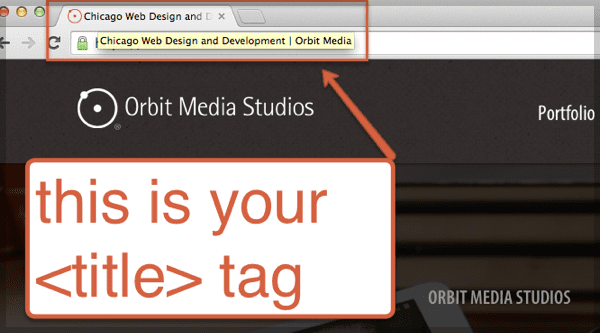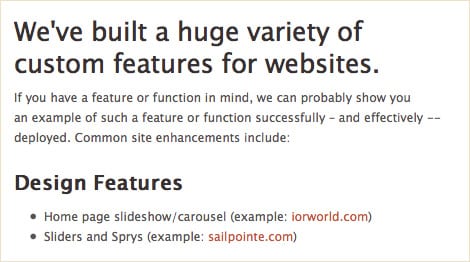I originally wrote this as a guideline document just for Orbit clients, but I figured “Hey, who doesn’t love a good checklist? I should share this with the world!” So here we are.
Below are eight tips on SEO best practices for on-page optimization. Let’s get started…
1. Title tags
Assuming you’ve already done your keyword research, this is one of the most important on-page SEO factors. If you haven’t, here is a step-by-step guide on how to research keywords.
The title tag tells search engines what the page is about and that the page on your website is relevant for that keyword or keyword phrase. Title tags should be unique for every page. In search results, search engines will highlight your keyword phrases if a user has searched for those terms. This increases visibility and click-through rate.
Let’s say you’re trying to rank for “Chicago Web Design”, your title tag may look like this:
Chicago Web Design and Development | Orbit Media
Best practices:
- Your title tag should be written like this: Primary Keyword – Secondary Keyword | Brand Name
- Use a dash in between your keyword phrases and a pipe at the end before your brand name
- Avoid duplicate title tags
- Keep title tags at 55 characters or less in length, including spaces. If you’re interested in learning more about the new title tag guidelines, check out this post by Dr. Pete.
Example of a title tag in a browser:

Example of a title tag in search engine results:

2. Meta descriptions
Meta descriptions, while not as important in search engine rankings, are extremely important in getting users to click through from the search engine results page (SERP) to your website. Meta descriptions should use keywords wisely, but more importantly they should include a compelling description on which a user would want to click on.
Much like title tags, the SERPs will highlight keywords that the user searched for, increasing the likelihood of the user clicking through to your website.
Best practices:
- Write compelling meta descriptions
- 150 to 160 characters is the recommended length
- Avoid duplicate meta descriptions
- Do not use quotes or any non-alpha characters (Google, cuts them out of the meta description)
Example of meta descriptions in search engine results:

3. Content with targeted keyword phrases
Your content is the meat and potatoes of your website. With all of the Google Panda updates, it is extremely important that your content is unique and relevant. If you have multiple pages with the same content (or if you have your content on other people’s websites), you will run the risk of getting penalized by Google and your search rankings will suffer.
We want to keep Google happy, so keep your content unique.
Best practices:
- Create content that is extremely relevant for that keyword phrase
- Use your keyword phrase 4 times within your content (but don’t abuse it)
- Include links from other pages within your website that point back to this page (see internal linking)
- Create unique content for every medium (press releases, blogs, guest blog posts, etc…). If you send out a press release, do not copy and paste that press release onto your website. If it gets picked up in multiple publications, the search engines will see that you have duplicate content and penalize you for it.
4. Header tags and keyword phrases
A header tag, also known as an H1 tag, is much like the subject line of your web page. You should only use your keyword phrase once in the H1 tag. This should be included on a page to which you are trying to drive unique traffic to. You can also use H2 tags (second header) if there are multiple sections.
Best Practices:
- Use your keyword phrase once in your H1 tag
- Use H1 tags on pages you are trying to drive unique traffic to (SEO page)
- Use H2 tags if there are multiple sections
Example of an H1 tag being optimized for ‘web design’:
5. Internal page linking with anchor text
Internal linking refers to a link on a page that points to another page on the same website. Internal linking is important because it helps strengthen those keywords internally for those pages, it allows users (and search engine robots) to navigate through the website, and it tells the search engines that the page is relevant for that keyword phrase.
Best practices:
- When linking to another page on the same site from within content, select good anchor text (keywords) to use in the actual link and do this often. For example: “We offer a wide range of web design services,” rather than “Click here for our services.”
- In the above example, you would link “web design services” to your web design services page instead of linking “click here.”
Example of how to use anchor text in your internal links:
The ecommerce text links to our ecommerce page, mobile links to our mobile page, etc. You get the picture!
6. Image ALT tags and filenames
An alt tag is essentially the name of an image. All images should use appropriate alt tags. Not only are alt tags good for search engines; they are also good for accessibility. If someone is using a screen reader, they will be able to hear what that image is.
You should try to include your keyword phrase in the name of your image, if possible, but don’t overdo it. Image filenames should also be SEO friendly. Image search is much more widely used than believed, so traffic from there is also valuable.
Best practices:
- Name all of your images in a way that describes what they are
- Use dashes between the words, rather than underscores ( purple-hat.jpg rather than purple_hat.jpg)
- Do not use non-alpha characters in your image or file names (so no %, &, $, etc…)
7. Make content easy to read
This is not a huge factor in search engine rankings, but will help your users easily scan your content and find the keywords they are looking for. You should use bolding and bullet points to set apart words in the text, and this further tells the engines what is important on the page. Don’t go wild or you’ll end up cluttering up your page and aggravating the user.
Best practices:
- Paragraphs should be roughly three sentences long. Extremely long sentences will lose the users’ attention
- Use bullet points and bolding to break up large blocks of content. Users tend to scan content looking for keywords
- Do not overuse bullets and bolding
Example of easy to read content:
8. Meta keywords
Meta keywords used to be popular back in the day. However, nowadays Google (or any other search engine for that matter) does not hold any weight to meta keywords, so go ahead and skip this.
If I missed anything, or if you have something to add, I’d love to hear your comments below!







